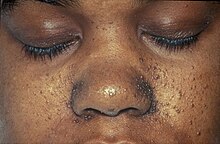Acneiform eruption
| Acneiform eruption | |
|---|---|
 | |
| Facial angiofibromas caused by tuberous sclerosis mimicking acne | |
| Specialty | Dermatology |
Acneiform eruptions, or acne mimicking eruptions, are a group of
Causes include cosmetics, the application of greasy products, and some medicines.[1] Repeated rubbing of skin and pressure are other triggers. The facial bumps of tuberous sclerosis can resemble acne. Any age can be affected.[2]
Signs and symptoms
Causes
Infections, changes in hormones or metabolism, genetic disorders, drug reactions, chemical contact, friction, and pressure can all cause acne-like eruptions.[2]
In general,
Acneiform eruptions can also be caused by other hormones.
Certain anticonvulsant medications can also aggravate pre-existing acne or trigger acneiform eruptions following a few weeks. This is a side effect of hydantoins, trimethadione, primidone, and phenobarbital. Dantrolene is a hydantoin derivative that can aggravate acne or cause acneiform eruptions.
A number of psychopharmacological drugs have been linked to acneiform eruptions. This effect is seen with phenothiazines, diazepam, and chloral hydrate, but particularly with lithium carbonate.[3]
Diagnosis
Acneiform eruptions differentiate themselves from acne vulgaris by a history of sudden onset, a monomorphic morphology, eruption development at any age, affecting the trunk more frequently than the face, not always affecting sebaceous areas of the body, and the rarity of cyst formation. In most cases, the diagnosis is made clinically, but if there is any doubt, a biopsy or culture of any discharge may be obtained. Another method for making a diagnosis is to withdraw the suspected medication.[2]
References
- ^ ISBN 978-3-319-49273-5.
- ^ PMID 29083685. Retrieved November 17, 2023.
- ^ ISBN 978-3-540-66751-3. Retrieved November 16, 2023.
- ISSN 1175-0561. Retrieved November 16, 2023.
